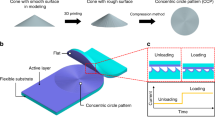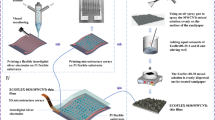Abstract
Flexible pressure sensors are evolving towards higher precision, larger areas, multi-sensing capabilities, increased resolution, and integration, imposing greater demands on the fabrication processes of flexible sensor devices. This study proposes a fully printed fabrication process utilizing electric field-assisted 3D micro-nanojet printing technology to manufacture capacitive sensors. Additionally, it designs sensor simulation studies based on hemispherical structures, cubic structures, and various microstructure arrangement densities to guide the preparation of capacitive pressure sensors. By utilizing PDMS mixed with 10% graphene material to print the dielectric layer with microstructures and conductive silver adhesive to print the electrode layer, the all-printing process significantly enhances the fabrication efficiency of flexible capacitive pressure sensors. The fabricated sensor achieves a maximum sensitivity of 0.7826 kPa−1 with a response time of 90 ms and a recovery time of 50 ms. It exhibits excellent responsiveness and stability during 4000 cycle tests, validating that the flexible capacitive pressure sensor, based on micro-nano-3D printing, can enhance the fabrication efficiency of flexible capacitive sensors and deliver outstanding performance.
Graphical abstract












Similar content being viewed by others
Explore related subjects
Discover the latest articles, news and stories from top researchers in related subjects.References
Pang Y, Xu X, Chen S, Fang Y, Shi X, Deng Y, Wang Z-L, Cao C (2022) Skin-inspired textile-based tactile sensors enable multifunctional sensing of wearables and soft robots. Nano Energy 96:107137. https://doi.org/10.1016/j.nanoen.2022.107137
Li P, Xie L, Su M, Wang P, Yuan W, Dong C, Yang J (2022) Skin-inspired large area iontronic pressure sensor with ultra-broad range and high sensitivity. Nano Energy 101:107571. https://doi.org/10.1016/j.nanoen.2022.107571
Sun F, Zhu Y, Jia C, Zhao T, Ye H, Wang K, Huang C, Xie Y, Mao Y (2024) Deep-learning-assisted neck motion monitoring system self-powered through biodegradable triboelectric sensors. Adv Funt Mater 34:2310742. https://doi.org/10.1002/adfm.202310742
Song H, Jang Y, Lee JP, Choe JK, Yun M, Baek Y-K, Kim J (2023) Highly compressible 3D-printed soft magnetoelastic sensors for Human-machine interfaces. ACS Appl. Mater. Interfaces 15:59776–59786. https://doi.org/10.1021/acsami.3c13638
Heng W, Solomon S, Gao W (2022) Flexible electronics and devices as human–machine interfaces for medical robotics. Adv Mater 34(16):2107902. https://doi.org/10.1002/adma.202107902
Sun F, Zhu Y, Jia C, Zhao T, Chu L, Mao Y (2023) Advances in self-powered sports monitoring sensors based on triboelectric nanogenerators. J Energy Chem 79:477–488. https://doi.org/10.1016/j.jechem.2022.12.024
Wang K, Yap LW, Gong S, Wang R, Wang SJ, Cheng W (2021) Nanowire-based soft wearable Human-machine interfaces for future virtual and augmented reality applications. Adv Funt Mater 31:2008347. https://doi.org/10.1002/adfm.202008347
Yu Y, Li J, Solomon SA (2022) All-printed soft human-machine interface for robotic physicochemical sensing. Sci Robotics 7:67. https://doi.org/10.1126/scirobotics.abn0495
Zhu Y, Zhao T, Sun F, Jia C, Ye H, Wang K, Huang C, Xie Y, Mao Y (2023) Multi-functional triboelectric nanogenerators on printed circuit board for metaverse sport interactive system. Nano Energy 113:108520. https://doi.org/10.1016/j.nanoen.2023.108520
Wang S, Deng W, Yang T, Ao Y, Zhang H, Tian G, Deng L, Huang H, Huang J, Lan B, Yang W (2023) Bioinspired MXene-based piezoresistive sensor with Two-stage enhancement for motion capture. Adv Funct Materials 33:2214503. https://doi.org/10.1002/adfm.202214503
Bai N, Wang L, Xue Y, Wang Y, Hou X, Li G, Zhang Y, Cai M, Zhao L, Guan F, Wei X, Guo CF (2022) Graded interlocks for iontronic pressure sensors with high sensitivity and high linearity over a broad range. ACS Nano 16:4338–4347. https://doi.org/10.1021/acsnano.1c10535
Du Y, Wang R, Zeng M, Xu S, Saeidi-Javash M, Wu W, Zhang Y (2021) Hybrid printing of wearable piezoelectric sensors. Nano Energy 90:106522. https://doi.org/10.1016/j.nanoen.2021.106522
Qu X, Liu Z, Tan P, Wang C, Liu Y, Feng H, Luo D, Li Z, Wang ZL (2022) Artificial tactile perception smart finger for material identification based on triboelectric sensing. Sci Adv 8(31):abq2521. https://doi.org/10.1126/sciadv.abq2521
Zhang Y, Yang J, Hou X, Li G, Wang L, Bai N, Cai M, Zhao L, Wang Y, Zhang J, Chen K, Wu X, Yang C, Dai Y, Zhang Z, Guo CF (2022) Highly stable flexible pressure sensors with a quasi-homogeneous composition and interlinked interfaces. Nat Commun 13:1317. https://doi.org/10.1038/s41467-022-29093-y
Tian H, Shu Y, Wang X, Mohammad M, Bie Z, Xie Q, Li C, Mi W, Yang Y, Ren T (2015) A Graphene-based resistive pressure sensor with Record-high sensitivity in a wide pressure range. Sci Rep 5:8603. https://doi.org/10.1038/srep08603
Lo LW, Zhao J, Wan H, Wang Y, Chakrabartty S, Wang C (2021) An Inkjet-printed PEDOT: PSS-based stretchable conductor for wearable health monitoring device applications. ACS Appl. Mater. Interfaces 13:21693–21702. https://doi.org/10.1021/acsami.1c00537
Liu J, Guo H, Li M, Zhang C, Chu Y, Che L, Zhang Z, Li R, Sun J, Lu YJ (2021) Photolithography-assisted precise patterning of nanocracks for ultrasensitive strain sensors. Mater. Chem. A 9:4262–4272. https://doi.org/10.1039/D0TA11374C
Zhang C, Zhou W, Geng D, Bai C, Li W, Chen S, Luo T, Qin L, Xie Y (2021) Laser direct writing and characterizations of flexible piezoresistive sensors with microstructures. Opto-Electron Adv 4(4):200061–200061. https://doi.org/10.29026/oea.2021.200061
Ling H, Chen R, Huang Q, Shen F, Wang Y, Wang X (2020) Transparent, flexible and recyclable nanopaper-based touch sensors fabricated via inkjet-printing. Green Chem 22:3208–3215. https://doi.org/10.1039/D0GC00658K
Wang D, Lu L, Zhao Z, Zhao K, Zhao X, Pu C, Li Y, Xu P, Chen X, Guo Y, Suo L, Liang J, Cui Y, Liu Y (2022) Large area polymer semiconductor sub-microwire arrays by coaxial focused electrohydrodynamic jet printing for high-performance OFETs. Nat Commun 13:6214. https://doi.org/10.1038/s41467-022-34015-z
Chen S, Bai C, Zhang C, Geng D, Liu R, Xie Y, Zhou W (2021) Flexible piezoresistive three-dimensional force sensor based on interlocked structures. Sens Actuators A: Phys 330:112857. https://doi.org/10.1016/j.sna.2021.112857
Zhang F, Jin T, Xue Z, Zhang Y (2022) Recent progress in three-dimensional flexible physical sensors. Int J Smart and Nano Mater 13:17–41. https://doi.org/10.1080/19475411.2022.2047827
Zhao K, Han J, Ma Y, Tong Z, Suhr J, Wang M, Xiao L, Jia S, Chen X (2023) Highly sensitive and flexible capacitive pressure sensors based on vertical graphene and micro-pyramidal dielectric layer. Nanomaterials 13:701. https://doi.org/10.3390/nano13040701
Kim H, Kim G, Kim T, Lee S, Kang D, Hwang M, Chae Y, Kang S, Lee H, Park H, Shim W (2018) Transparent, flexible, conformal capacitive pressure sensors with nanoparticles. Small 14:1703432. https://doi.org/10.1002/smll.201703432
Chhetry A, Sharma S, Yoon H, Ko S, Park J (2020) Enhanced sensitivity of capacitive pressure and strain sensor based on CaCu3 Ti4 O12 wrapped hybrid sponge for wearable applications. Adv Funct Mater 30:1910020. https://doi.org/10.1002/adfm.201910020
Qiu J, Guo X, Chu R, Wang S, Zeng W, Qu L, Zhao Y, Yan F, Xing G (2019) Rapid-response, low detection limit, and high-sensitivity capacitive flexible tactile sensor based on three-dimensional porous dielectric layer for wearable electronic skin. ACS Appl Mater Interfaces 11:40716–40725. https://doi.org/10.1021/acsami.9b16511
Acknowledgements
This work was supported by the National Key R&D Program of China (Grant No.2021YFB3201600) and the Key Research Projects of basic scientific research projects of Liaoning Provincial Department of Education (Grant No. JYTZD2023169).
Author information
Authors and Affiliations
Contributions
Ke Xu provided the funding and writing ideas. Changtong Wang performed the experiments and wrote the paper. Zixuan Zhang and Yuhe Tang polished the paper. Hongji Guo carried out the overall goal formulation. Both authors have read and agreed to the published version of the manuscript.
Corresponding author
Ethics declarations
Conflict of interest
The authors declare that they have no known competing financial interests or personal relationships that could have appeared to influence the work reported in this paper.
Additional information
Handling Editor: David Cann.
Publisher's Note
Springer Nature remains neutral with regard to jurisdictional claims in published maps and institutional affiliations.
Rights and permissions
Springer Nature or its licensor (e.g. a society or other partner) holds exclusive rights to this article under a publishing agreement with the author(s) or other rightsholder(s); author self-archiving of the accepted manuscript version of this article is solely governed by the terms of such publishing agreement and applicable law.
About this article
Cite this article
Xu, K., Wang, C., Zhang, Z. et al. Flexible capacitive pressure sensor based on electrically assisted micro-nanoimprinting. J Mater Sci 59, 13575–13590 (2024). https://doi.org/10.1007/s10853-024-09987-6
Received:
Accepted:
Published:
Issue Date:
DOI: https://doi.org/10.1007/s10853-024-09987-6




